NOTES
Sunday, July 22, 2007
07:05
White sky
Birds:
1. mrgo (Mr. Go)
2. mwbw (Checkers)
3. mlbob (Mrs. Go)
4. unbanded (Shopper)
5. mlbrg (Trapper) chased by mwbw
6. morlb (Red Eye)
7. mwrg (Wringer) missing middle tail feather
8. lbpmp (Princesa)
9. mpbw (Mrs. Red Eye)
10. mgrr (Droopy)
11. unbanded
12. mwlblb (Tame Bird)
07/20/07
07:32
Cloudy mixed with blue sky
Birds:
1. mwrlb (Red Eye)
2. mpbw (Mrs. Red)
3. mrgo (Mr. Go)
4. mlbrg (Trapper)
5. Shopper
6. mlbob (Mrs. Go)
7. lbpmp (Princesa)
8. mwrg (Wringer)
9. plump juvenile
10. mgrr (Droopy)
11. mwbw (Checkers)
07/19/07
06:13
White sky
Birds:
1. mrgo (Mr. Go)
2. mlbob (Mrs. Go)
3. mgrr (Droopy)
4. unbanded juvenile (begs to Droopy)
5. mwlblb (Tame Bird)
6. lbpmp (Princesa)
7. mlbrg (Trapper)
8. Shopper (Chopper)
9. morlb (Red Esye)
10. mwrg (Wringer)
11. mwbw (Checkers)
07/18/07
06:57
Blue sky with clouds—trees drenched with water after a summer rain.
Birds:
1. mlbob (Resident Female)
2. Mrgo (Resident Male)
3. unbanded juvenile
4. Shopper
Notes:
After an absence of a week, my birds have fallen out of the peanut routine. Only Mrs. Go answers my morning greeting. She sits, perched in the tree, camouflaged, waiting quietly without calling or moving. She swoops in quickly, grabs a nut, not taking time to do her usual cross-over, two peanut pick-up. She appears cautious. Her legs are the most swollen ever—in particular the left. She favors it, lifting it as she hops in a lop-sided gait. She is wet and rumpled, a feather on her back sticking up; molting has begun.
Mr. Go arrives with a squa, squa call—only 11 minutes past the time I began watching. He looks particularly sleek, and confident, standing tall, in an alert posture, hop, hop, hopping off a flat surface into a strong, flying take-off.
An unbanded juvenile sits, perched on a branch quietly. Its wings flutter rapidly, quietly, in a begging posture, as Mr. Go arrives. The bird has aged since I last saw it, the pink around its gape has filled in some, and the downy quality of its feathers has matured. It appears taller, leaner, the circumference of its neck narrowed, not so round and plump—more adolescent in its attitude. It perches, calls, squa, squa, squa and then tchoo choo choo TCHU choo choo, TCHU. It sounds immature, tentative. It wipes its bill back and forth on a tree branch, and tap taps. I wonder if this is a way of marking territory, leaving behind a scent, a bill-cleaning ritual, or has some other significance I’m unaware of. The three birds are casual, taking their time to collect peanuts, as if they have no competition and all the time in the world to feed. An hour later, only the nuclear family has come to feed, lots of peanuts are left.
Chopper is the first to arrive outside the family group. He does his usual pick up/put down routine before selecting. Mr. Go cheep cheeps, calls chooka, chooka, chooka and begins feeding on sunflower seeds. A second juvenile arrives and begs, bill open, wings fluttering, standing next to Mr. Go on the bench.
White sky
Birds:
1. mrgo (Mr. Go)
2. mwbw (Checkers)
3. mlbob (Mrs. Go)
4. unbanded (Shopper)
5. mlbrg (Trapper) chased by mwbw
6. morlb (Red Eye)
7. mwrg (Wringer) missing middle tail feather
8. lbpmp (Princesa)
9. mpbw (Mrs. Red Eye)
10. mgrr (Droopy)
11. unbanded
12. mwlblb (Tame Bird)
07/20/07
07:32
Cloudy mixed with blue sky
Birds:
1. mwrlb (Red Eye)
2. mpbw (Mrs. Red)
3. mrgo (Mr. Go)
4. mlbrg (Trapper)
5. Shopper
6. mlbob (Mrs. Go)
7. lbpmp (Princesa)
8. mwrg (Wringer)
9. plump juvenile
10. mgrr (Droopy)
11. mwbw (Checkers)
07/19/07
06:13
White sky
Birds:
1. mrgo (Mr. Go)
2. mlbob (Mrs. Go)
3. mgrr (Droopy)
4. unbanded juvenile (begs to Droopy)
5. mwlblb (Tame Bird)
6. lbpmp (Princesa)
7. mlbrg (Trapper)
8. Shopper (Chopper)
9. morlb (Red Esye)
10. mwrg (Wringer)
11. mwbw (Checkers)
07/18/07
06:57
Blue sky with clouds—trees drenched with water after a summer rain.
Birds:
1. mlbob (Resident Female)
2. Mrgo (Resident Male)
3. unbanded juvenile
4. Shopper
Notes:
After an absence of a week, my birds have fallen out of the peanut routine. Only Mrs. Go answers my morning greeting. She sits, perched in the tree, camouflaged, waiting quietly without calling or moving. She swoops in quickly, grabs a nut, not taking time to do her usual cross-over, two peanut pick-up. She appears cautious. Her legs are the most swollen ever—in particular the left. She favors it, lifting it as she hops in a lop-sided gait. She is wet and rumpled, a feather on her back sticking up; molting has begun.
Mr. Go arrives with a squa, squa call—only 11 minutes past the time I began watching. He looks particularly sleek, and confident, standing tall, in an alert posture, hop, hop, hopping off a flat surface into a strong, flying take-off.
An unbanded juvenile sits, perched on a branch quietly. Its wings flutter rapidly, quietly, in a begging posture, as Mr. Go arrives. The bird has aged since I last saw it, the pink around its gape has filled in some, and the downy quality of its feathers has matured. It appears taller, leaner, the circumference of its neck narrowed, not so round and plump—more adolescent in its attitude. It perches, calls, squa, squa, squa and then tchoo choo choo TCHU choo choo, TCHU. It sounds immature, tentative. It wipes its bill back and forth on a tree branch, and tap taps. I wonder if this is a way of marking territory, leaving behind a scent, a bill-cleaning ritual, or has some other significance I’m unaware of. The three birds are casual, taking their time to collect peanuts, as if they have no competition and all the time in the world to feed. An hour later, only the nuclear family has come to feed, lots of peanuts are left.
Chopper is the first to arrive outside the family group. He does his usual pick up/put down routine before selecting. Mr. Go cheep cheeps, calls chooka, chooka, chooka and begins feeding on sunflower seeds. A second juvenile arrives and begs, bill open, wings fluttering, standing next to Mr. Go on the bench.
Subscribe to:
Post Comments (Atom)
Pia Sets the Trap

07/24/07
Peaking...

07/24/07
Oops, wrong bird!

Demonstrating the "hold"
Try Again

Bird in the Bag
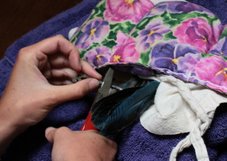
Applying a metal band
Measuring

and more measuring. . . .
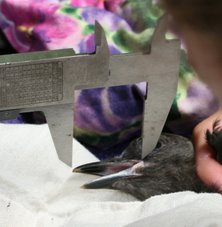
Blood Sampling

Jeff J's Work

Pia's test tube holder
Weighing
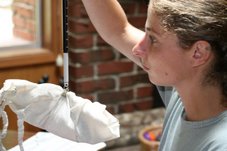
And then....release
When the sun goes down...

Steller's Jay Taxonomy/Description
Common Name: Steller's Jay
Class: Aves
Order: Passeriformes
Family: Corvidae
Genus: Cyanocitta
Species: Cyanocitta stelleri
Steller’s jay belongs to the family, Corvidae, in the Avian Order Passeriformes. Passeriformes is the order of perching birds. Corvidae is the jay, magpie and crow family. The Steller's jay's scientific name is Cyanocitta stelleri. The generic name, cyanocitta, means "blue jay". Its specific name, stelleri, named for George W. Steller (1709-1746). Steller was a German zoologist who explored the coastal areas of the northern Pacific Ocean in 1740.
Band Colors
black | white | purple | red | orangeBands are read in the following order:
light blue and light blue | green
Note: Light blue is difficult to read. It darkens with age, resembling a green band. (b/w/p/r/o/lb/g)
right bottom band
right top band
left bottom band
left top band
Data Collecting
This information was copied from the website of Dr. Jeff Black, Humboldt State University Wildlife Department.
The data to include for each record:
- Bird’s color code
- Size of social group seen at the same time
- Associates’ color codes (or if unbanded = UNB; or not determined = NOTD)
- Number of times associates came within 3 meters of each other
- Approximate time spent within 3 meter distance (e.g. 2 seconds, 15 sec, etc.)
- Total time you watched the birds (e.g. 5 minutes, 10 min, etc.)
- Time of day; start of observation (e.g. 1935)
- Date (e.g. 9.30.99)
- Location of observation (e.g. Rewood Bowl SW corner west bleachers. And state whether the bird was seen at a birdfeeder or in trees, etc)
- Comments (e.g. deformed leg, feather tuft on back, etc.)
Arcata Steller's Jay Sightings
Mr. Go










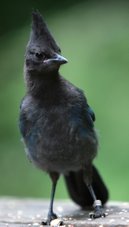










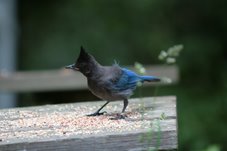











No comments:
Post a Comment